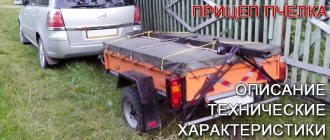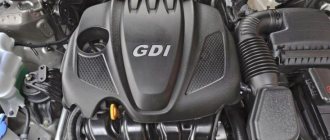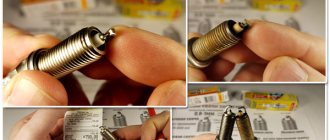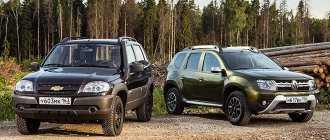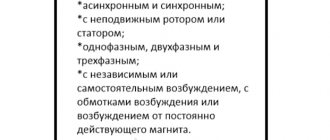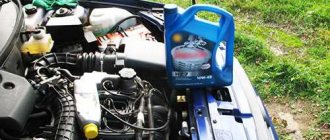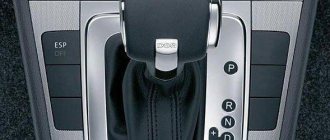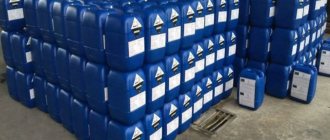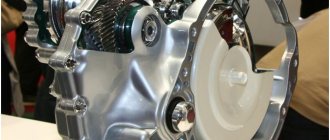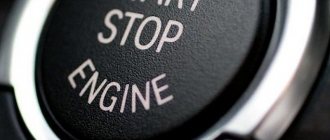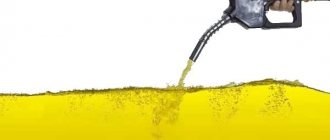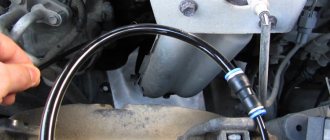Today we’ll talk about why you can’t pour antifreeze concentrate in its pure form, at least at sub-zero temperatures. Why, read this detailed article if you value the cooling system of your car. And of course, you will learn how to properly dilute the concentrate and pour it into the system.
Rating TOP 7 best antifreeze concentrates
Our rating includes the following antifreeze concentrates:
- Sintec Ultra.
- SINTEC EURO.
- Motul Inugel Expert.
- CoolStream Premium.
- LIQUI MOLY Langzeit Kuhlerfrostschutz GTL 12 Plus.
- SINTEC LUX.
- Motul Inugel Ultra.
Let's take a closer look at each tool.
Sintec Ultra
from 400 to 700 rub.
7th place 4.1/5
The main feature of the presented product is the temperature at which crystallization begins, which exceeds the requirements by a margin: the antifreeze remains operational down to -45 °C. In addition, it also demonstrates excellent anti-corrosion properties. The product is compatible with both aluminum and copper radiators.
| Freezing point | -45 °C |
| pH value | 7,9 |
| Color | raspberry red |
- excellent freezing temperature margin (-45 °C);
- low corrosion activity;
- protects the engine from overheating and frost.
- antifreeze replacement time (3 years);
- information from the manufacturer is written in English.
Since last fall I have been using SINTEC ULTRA G11 antifreeze and am completely satisfied with its properties. Firstly, the low crystallization temperature (according to the passport -45 degrees). Secondly, it does not form scale (over a year of operation there are no signs of dirt or other deposits in the cooling system). Thirdly, it perfectly maintains the temperature in the engine. Before adding this product, first flush the cooling system and replace all rubber pipes and clamps. I am very pleased with this antifreeze.
Antifreeze Sintec Ultra
SINTEC EURO
from 400 to 600 rub.
6th place 4.2/5
The company of this antifreeze is not the most “advanced” in terms of temperature indicators. Boils at temperatures up to +111 °C. Owners of car brands such as VAZ, GAZ, Daewoo, Kia can safely use this product for the time stated by the manufacturer. Among the positive properties, one can note a large number of lubricating additives that extend the overall service life of the water pump and actively resist cavitation. A worthy example for both used and new vehicles.
| Freezing point | -40 °C |
| pH value | 7,9 |
| Color | green |
- low corrosion activity;
- does not freeze in severe frost (from -40 °C);
- high boiling point (+111 °C).
- short replacement period (3 years).
I tried a large number of G11 and G12 antifreezes, and when I used this concentrate, I left the choice on it. The first thing that can be said about the product is that it is produced in the city of Obninsk at ZAO Obninskorgsintez, a worthy enterprise that has repeatedly proven the quality of this product. I'm happy with the purchase and recommend it to everyone.
Antifreeze SINTEC EURO
Motul Inugel Expert
from 1300 to 1500 rub.
5th place 4.3/5
This ready-made antifreeze fits within the stated and standard crystallization temperature, albeit with a small margin (-38 degrees). It is characterized by the absence of noticeable aggressiveness towards aluminum and a high alkaline number. He “likes” copper alloys and solder least of all, but within the tolerance limits of the standards.
| Freezing | -40 °C |
| Hydrogen indicator | 8,2 |
| Color | blue, light blue |
- effectively cools the engine;
- protects the engine from defrosting and prevents corrosion of metal parts;
- excellent compatibility with aluminum.
- not found.
I buy it from a Motul dealer, I have no doubt about the quality. From replacement to replacement it survives clean, does not turn red, and there is no sediment. In a word, we have before us an antifreeze concentrate that is not cheap, but made in full accordance with the requirements of standards and quality. But, of course, you should buy in large stores, and not at the car market - alas, we also like to counterfeit.
Antifreeze Motul Inugel Expert
CoolStream Premium
from 900 to 1030 rub.
4th place 4.4/5
Coolant is produced using carboxylate technology. It has a long service life - up to 250 thousand km in cars, and up to 650 thousand km in freight vehicles. This domestic product is distinguished by the stability of its qualities and high thermal conductivity, head and shoulders ahead of silicate antifreezes. Effectively protects the system and engine from corrosion, overheating, freezing and premature wear.
| Freezing | -40 °C |
| Hydrogen indicator | 8,6 |
| Color | orange |
- long service life (5 years);
- provides protection against corrosion;
- filled at many factories (AVTOVAZ, LiAZ, Deutz Ford, Fiat, MAN, Mercedes-Benz, MTU).
- not found.
I would like to share my many years of experience using Coolstream antifreeze. Let me start with this: I have a fairly old Ford, and I carefully monitor its condition. When I first bought it new, I immediately asked the car dealership what kind of antifreeze was in it, and they said Coolstream. After 6 years, it was time to change the coolant, I monitored the market and realized that after all, Coolstream is the best option for my car. They drained the product in the salon and I couldn’t believe my eyes - the product remained clean and bright, like new.
Antifreeze CoolStream Premium
LIQUI MOLY Langzeit Kuhlerfrostschutz GTL 12 Plus
from 1850 to 2079 rub.
3rd place 4.5/5
German antifreeze, repeatedly tested and awarded high reviews from car manufacturers. The red tint clearly indicates that they belong to carboxylate coolants; they are based on organic additives. The positive effect of using this coolant is the almost perfect protection of water pump blades from cavitation, and metal parts from corrosion.
| Freezing | -40 °C |
| Hydrogen indicator | 8,2 |
| Color | red |
- high boiling point (109 °C);
- optimal corrosion protection;
- Provides excellent protection against freezing, rust and overheating.
- Minimum packaging – 5 liters.
I trust the brand - even if the price is a little high, but I’m used to working with Liqui Moly products, their quality is good. I change antifreeze every two years, I take care of my car and I’m not going to skimp on fluids. I recently filled up with Liqui Moly red concentrate for the third time. I can say for sure that the car drives 40 thousand km on it with a bang. The product itself does not change color and does not form corrosion inside.
Antifreeze LIQUI MOLY
SINTEC LUX
from 450 to 600 rub.
2nd place 4.7/5
The concentrate is popular both among consumers and the AvtoVAZ dealer. The standard service life is five years, and in terms of mileage - 250 thousand kilometers for passenger cars. The composition is literally stuffed with all kinds of organic additives, modifiers and catalysts, the combined action of which leads to an effective fight against traces of corrosion, scale, solid inclusions and allows you to keep the system perfectly clean. Despite the simplicity of the packaging, consumers do not often complain about purchasing counterfeits. Based on a set of control parameters, it proved to be better than its analogues.
| Freezing | -40 °C |
| pH value | 7,8 |
| Color | red |
- a small number of fakes on the market;
- crystallization occurs at a temperature of -40 °C;
- excellent corrosion protection.
- not detected.
Normal, inexpensive antifreeze. I think at this price there’s really no point in counterfeiting it. Within its class, Sintek performs confidently. By the way, if your car left the Tolyatti assembly line later than 2011, then it is this brand of coolant that is filled in it. It has a good temperature reserve, its chemical activity is moderate, don’t forget to change it according to the regulations, and no serious problems will happen to it.
Antifreeze SINTEC LUX
Motul Inugel Ultra
from 3500 to 4950 rub.
1 place 4.9/5
Coolant from Motul is sold ready-to-use. The product can withstand low temperatures down to -50°C, after which crystallization begins. An ideal option suitable for modern, high-tech engines, which the product in question reliably protects from freezing, overheating and corrosion. During operation, no precipitate is formed and the solution does not change color.
| Freezing point | -50 °C |
| pH value | 8,5 |
| Color | pink |
- maximum safe temperature – up to +179 °C;
- does not have a negative effect on rubber elements;
- Excellent heat dissipation.
- not detected.
I purchased ready-to-use coolant for the first time in 2011 (previously I used products from another brand). Purchased at your own risk. After purchasing the car, I decided to change all the fluids and bought oils from an official Motul dealer, and at the same time decided to purchase a ready-made coolant.
After replacing the fluid, 5 years and about 60 thousand kilometers have passed, and a third of them were on a sports track. During all this time, the car’s engine never overheated; the fluid served its purpose 100%.
Antifreeze Motul Inugel Ultra
What is the difference between antifreeze and antifreeze?
Most experienced drivers know that both products are coolants, which differ in their technical and operational characteristics. Let's take a closer look at them.
Initially, “antifreeze” was developed for the cooling system of Soviet cars in the 70s of the last century. This was a liquid improved at the GosNIIOKhT Institute, which replaced the ordinary water that had previously been poured into the radiators. For old cars with brass radiators and cast iron motors, this cooling method was safe, but for more modern engines it threatened to damage the cylinder block, pipes or the entire system as a whole. The composition of the new product, called “antifreeze,” in addition to water, included ethylene glycol and additives based on inorganic salts, which protected the internal combustion engine from corrosion.
As for antifreeze, these are the same coolants, but only imported and with a more advanced composition. Antifreeze, unlike its foreign counterpart, forms an anti-corrosion layer 0.5 mm thick over the entire surface of the system.
Because of this, the metal transfers heat less well, and the efficiency of the cooling process is noticeably reduced, accelerating engine wear and increasing fuel consumption. In addition, antifreeze loses its performance characteristics after 35,000-40,000 km. In turn, the imported product “works” more delicately, forming a protective layer not over the entire surface, but only on problem areas of the system. Thanks to this, heat exchange is not disturbed and the service life of the unit is extended. In addition, antifreeze is more resistant to boiling (115°C) than antifreeze (107°C) and its replacement is required after 250,000 km.
ON A NOTE!
It is prohibited to mix antifreeze with antifreeze at the same time due to the difference in composition.
Unlike imported coolant, antifreeze contains aggressive silicate, which negatively affects the channels. The consequences of mixing two products without flushing the cooling system can be corrosion, sediment that will clog the channels, deterioration in the performance properties of the liquid, etc.
Comparison of the presented funds
In order to compare the presented funds, we suggest taking a look at the comparison table below.
| Model | VAG approval index | Freezing point (°C) | pH value | Color | Price, rub) |
| Sintec Ultra | G11 | -45 | 7,9 | raspberry red | from 400 to 700 |
| SINTEC EURO | G11 | -40 | 7,9 | green | from 400 to 600 |
| Motul Inugel Expert | G11 | -40 | 8,2 | blue-green | from 1300 to 1500 |
| CoolStream Premium | G12+ | -40 | 8,6 | orange | from 900 to 1030 |
| LIQUI MOLY Langzeit Kuhlerfrostschutz GTL 12 Plus | G12+ | -40 | 8,2 | red | from 1850 to 2079 |
| SINTEC LUX | G12 | -40 | 7,8 | red | from 450 to 600 |
| Motul Inugel Ultra | G13 | -40 | 8,5 | pink | from 3500 to 4950 |
Types and classification
There are no specific global standards for antifreeze, but as a rule, the classification developed by the VAG concern is taken as a basis. So there are three classes:
- G11;
- G12;
- G13.
G11
These are traditional antifreezes based on ethylene glycol and various silicone additives that protect against corrosion. They are also called silicone antifreeze.
G11, G12, G13
Due to the formation of a protective layer, they can significantly reduce heat transfer, as well as form abrasive particles (falling off of the layer from the walls). Antifreeze of this class needs to be changed at least once every two years.
G12, G12+, G12++
G12 was the next stage in the development of antifreeze. Mainly, they solved the problem of the formation of a layer that interfered with heat transfer. This class uses carboxylic acids. The downside is that these acids attack corrosion after it occurs, not before. Increased heat transfer and service life up to 5 years.
Effect of carboxylate antifreeze G12+, G12++
Such coolants are marked:
- G12.
- Carboxylate coolants.
- OAT (Organic Acid Technology).
In the subsequent generation G12+ and G12++, they also solved this problem by combining organic and mineral additives together. Such coolants are often called lobrid and are labeled:
- Lobrid coolants.
- SOAT coolants.
G13
This class appeared in 2012 and differs from previous ones in the use of propylene glycol as a base. As already mentioned, this substance is safe for humans and the environment. This is where the differences, in general, end.
How to dilute the concentrate?
The product packaging must contain detailed instructions for dilution with distilled water. In this case, you need to focus on the climate zone in which the machine is operated. If the temperature in the cold season rarely drops below -20 °C, there is no point in diluting antifreeze. Operate in temperatures between -25 and -40°C.
Before pouring the product in question into the radiator, it must be diluted with water, because it is not intended for use, but for the preparation of coolants with different freezing temperatures from it.
Antifreeze concentrate is almost 100% ethylene glycol (no more than 5% water) with concentrated additives added to it. The temperature of this product is -13 °C. To obtain coolant with a freezing point of -39-40 °C, the concentrate is diluted with water in a 1:1 ratio. So that the freezing temperature corresponds to -30 °C - in a ratio of 2:3. Temperature -20 °C - in a ratio of 1:2.
It is best to dilute with distilled water, there is a 100% guarantee that no sediment will form either during dilution or during operation. If the manufacturer says that dilution with ordinary water is allowed, then it is better to first check this information by preparing a small volume of antifreeze solution in the ratio you need using your tap water. Leave for 12 hours, let it stand and, if there is no cloudiness or sediment, prepare the solution and safely pour it into the radiator.
Please note that in this case the principle “the more water, the lower the freezing point” does not work. By pouring a lot of water, the coolant will lose its ability to withstand low temperatures.
Coolant composition
All antifreezes have the same composition:
- 90%
– ethylene glycol (propylene glycol) base; - 5-7%
– a complex of additives (anti-corrosion, anti-foam, stabilizing); - 3-5%
– water; - dye
(mostly red, green or blue).
NOTE!
Ethylene glycol is an oily, sweetish liquid that is a potent poison. The lethal dose for an adult is 200-250 ml. Ethyl alcohol will help neutralize the effect of the poison.
What to look for when choosing
Before purchasing antifreeze, you should be sure to familiarize yourself with the composition and check the data with the information specified in the car manual.
Let's consider the main criteria for choosing antifreeze concentrate.
- Appearance. Cloudiness and sediment are not allowed; the box must be of high quality, with a good label. A disposable ratchet plug (or a membrane under it) must also be present.
- Smell. The coolant has almost no odor. The smell of gasoline or diesel fuel is unacceptable. Also, the product should not foam - after shaking the canister, the foam should settle in 3-5 seconds.
- Popularity. It is recommended to purchase only well-known and popular products that have been tested over a long period of time. If the product is not familiar to you, and the seller cannot really tell you about the manufacturer, leave the antifreeze alone and look for a more well-known and high-quality concentrate.
Which antifreeze should you choose for your car?
It is almost impossible to unequivocally answer the question of which antifreeze is better. For example, unlike modern cars, vehicles older than 20 years are not demanding on the composition - they can be filled with antifreeze and antifreeze. Therefore, to make it easier for you to choose the right product, use the recommendations of experts:
- You need to select the coolant based on the car repair and operation instructions (manual), which indicate the manufacturer’s requirements for technical fluids.
- When choosing a product, you must take into account the temperature range of your region (maximum sub-zero temperatures). Antifreeze should always be purchased with a reserve.
- When choosing antifreeze, you should always pay attention to its packaging and appearance. The container must be sealed, free from defects, the label indicates the manufacturer, its location, details, expiration dates and date of manufacture of the product. The coolant itself should be free of sediment (flakes), and the foam that appears when shaking the canister should disappear in a couple of seconds (in concentrate - a maximum of 5 seconds).
Main manufacturers
In Russia, according to conventional estimates, about 95 types of coolants for automobiles and specialized vehicles are produced. Of these, the largest market representatives are:
- Sintec , which has won many awards for the quality and reliability of its products, has OEM approvals.
- Felix, which has approval certificates from BMW, MAN and Volkswagen factories.
- Alaska , a Russian-American enterprise present on the market since 1980.
- CoolStream , which is one of the largest manufacturers of cooling agents in our country.
- Luxe , whose range includes new generation lobrid antifreezes.
- Lukoil , which produces products approved for use on MAN, Mercedes-Benz and MTU vehicles.
The share of foreign companies in the Russian coolant market is less than 13%. These include:
- Mobil (USA), producing high-quality reagents in concentrated form.
- Febi (Germany).
- Ravenol (Germany), an independent manufacturer producing coolants using innovative technologies.
conclusions
- Automotive antifreeze is sold in a concentrated composition, which should be mixed with purified water in a ratio of 50 to 50. However, this concentration of mixing water and coolant may undergo certain changes depending on how you use your car.
- Without fear, you can mix different antifreezes that have a common base and components that meet established quality standards. However, the characteristics of such a liquid are very often not written by the company, and therefore the buyer only has to follow the instructions on the packaging.
- Different types of mixtures (with artificial and natural additives) can only be mixed if specified by the manufacturer.
- Antifreeze in a car is a cooling mixture that is poured into the car's engine cooling system. By circulating around the radiator, such coolant will help remove excess thermal energy from the engine so that it does not heat up and break down during operation.
- Machine antifreeze is conventionally divided depending on the type of additives that are used in it: you can find lobrid type antifreeze on sale, and there are also a large number of carboxylate antifreezes and mixed type antifreezes on the market.
